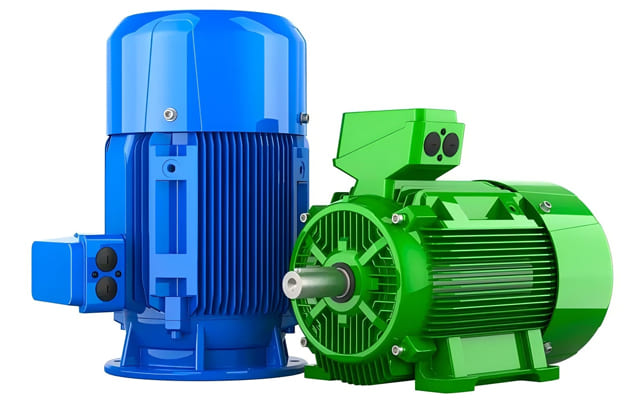A permanent magnet generator (PMG) is a type of electrical generator that converts mechanical energy into electrical energy using the magnetic field generated by permanent magnets. Known for its high efficiency, compact design, and low maintenance, PMG technology is becoming increasingly popular across various sectors, including wind power, automotive, aerospace, and portable power systems. As the demand for clean energy grows, understanding how a permanent magnet generator works is more important than ever.
1. What Is a Permanent Magnet Generator?
Unlike conventional generators that require an external power source to excite the rotor field, a permanent magnet generator uses high-strength magnetic materials—such as neodymium (NdFeB)—to create a constant magnetic field. This eliminates the need for brushes, slip rings, and excitation windings, making PMGs ideal for applications that require efficiency, durability, and energy savings.
Key Benefits:
-
No external excitation required
-
Brushless operation reduces mechanical wear
-
High power-to-weight ratio
-
Improved energy efficiency (up to 80%)
-
Environmentally friendly with low energy losses
2. Structure of a Permanent Magnet Generator
A typical PMG consists of two major components: the stator and the rotor.
-
Stator: The stator contains three-phase copper windings arranged in a symmetrical pattern (often in a four-pole configuration). When the magnetic field from the rotor interacts with the stator, it induces alternating current (AC) voltage.
-
Rotor: The rotor is equipped with a series of permanent magnets aligned around the circumference. These magnets rotate with the mechanical input (e.g., wind turbine shaft), cutting through the stator windings and generating electricity via electromagnetic induction.
-
Pole Configuration: Most PMGs use an even number of magnetic poles (such as 2, 4, or 8), which directly impacts the generator’s frequency and voltage output.
3. Working Principle of Permanent Magnet Generators
The fundamental principle of operation is Faraday’s Law of Electromagnetic Induction, which states that a change in magnetic flux through a coil induces an electromotive force (EMF).
As the rotor spins, the permanent magnets create a rotating magnetic field that passes through the stationary coils in the stator. This changing magnetic flux induces voltage in the stator windings, producing usable AC power.
The output voltage and current depend on three factors:
Strength of the permanent magnets
Rotor speed (RPM)
Number of turns in the stator windings
4. Permanent Magnet Synchronous Generator (PMSG)
A permanent magnet synchronous generator is a specialized type of PMG in which the rotor rotates at the same speed as the stator’s rotating magnetic field. This synchronous operation ensures stable voltage and frequency, making it ideal for wind turbine applications, especially in off-grid and variable-speed systems.
Key Features:
-
Zero slip (synchronous operation)
-
Enhanced voltage regulation
-
High dynamic response
-
Ideal for renewable energy systems
5. PMG vs Traditional Excited Generators
| Feature | Permanent Magnet Generator (PMG) | Traditional Excited Generator |
|---|---|---|
| Magnetic Field Source | Permanent magnets | External excitation power |
| Brushless Operation | Yes | No (uses brushes and slip rings) |
| Energy Efficiency | High (75%–80%) | Lower (typically 45%–55%) |
| Maintenance Requirement | Low | High (due to mechanical wear) |
| Start-up Ability | Self-starting | Requires excitation or battery |
| Environmental Suitability | Better for harsh/off-grid environments | Less suitable without auxiliary power |
6. Advantages of Permanent Magnet Generators
1. Energy Efficiency
PMG systems eliminate the need for electrical excitation and mechanical friction from brushes, allowing for more efficient energy conversion. Especially in renewable energy systems like wind turbines or micro-hydro plants, this increased efficiency results in greater energy output with lower input energy.
2. Low Maintenance
Brushless and gearless designs reduce the number of moving parts, minimizing wear and the risk of mechanical failure. PMGs are ideal for remote or unmanned locations where maintenance is costly or difficult.
3. Compact Design
Thanks to the high energy density of modern magnets, PMGs offer a smaller footprint and lighter weight compared to traditional alternators with the same output power.
4. Self-Starting Capability
With the right voltage regulation system, a PMG can start generating power without needing an external power supply or battery, making it an excellent choice for emergency backup systems or off-grid power kits.
7. Real-World Applications
-
Wind Turbines: Direct-drive PMGs eliminate gearbox losses and simplify turbine architecture.
-
Electric Vehicles (EVs): Regenerative braking systems and drive motors benefit from PMG efficiency.
-
Microgrids and Off-Grid Power Systems: PMGs are a core component of wind-solar hybrid systems, where reliability and maintenance-free operation are key.
-
Portable Emergency Generators: Lightweight PMGs are used in military and medical field kits.
-
DIY Power Projects: Hobbyists often repurpose motors from electric bikes or scooters into small-scale PMGs.
Tip: Strong neodymium magnets from salvaged e-bike motors can be reused to build low-cost DIY PMGs for education or off-grid experimentation.
8. Efficiency Comparison
In a typical use case:
-
Traditional Excited Generator (at 1500–6000 RPM):
Average efficiency = 45%–55% -
Permanent Magnet Generator (same speed):
Average efficiency = 75%–80%
This significant increase in energy conversion is one of the major reasons why PMGs are widely adopted in renewable energy applications.
9. Why Choose a Permanent Magnet Generator?
If you’re seeking a reliable, efficient, and low-maintenance power generation solution, a permanent magnet generator is a future-proof choice. Whether you’re powering a small cabin, integrating with a solar-wind hybrid system, or building a sustainable off-grid power setup, PMGs deliver outstanding performance with minimal complexity.
Learn More from Elege New Energy
At Elege New Energy, we specialize in custom-designed permanent magnet generators for off-grid systems, wind turbines, and hybrid energy solutions. Our PMGs are engineered for high efficiency, long lifespan, and ease of installation—backed by years of manufacturing expertise and global partnerships.
🔗 Visit us at: https://energy-elege.com
🌀 Explore our PMG line: from small-scale home models to industrial-grade wind turbines.

